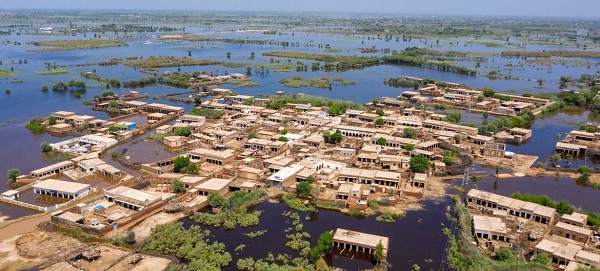Climate change intensifies monsoon flooding; one-third of Pakistan is under water
3 min read
1.1 million homes lost; 33 million affected; 6.4 million in dire need
(INDUS RIVER WATERSHED, Pakistan, Sept. 2, 2022) – A third of Pakistan is under water after flooding. The scale of the humanitarian crisis in Pakistan is also unprecedented, UN humanitarians warned on Friday.
With more than 33 million people impacted, that represents 15 per cent of the total Pakistani population, said Dr. Palitha Mahipala, World Health Organization (WHO) representative in the country.
Some “6.4 plus million people are in dire need of humanitarian aid,” he said, speaking from Islamabad to journalists in Geneva.
In the past few weeks, record monsoon rains dumped more than five times the 30-year average for rainfall in some provinces, killing more than 1,200 people and injuring over 6,000 since June. Nearly 400 children are among the fatalities.
More than a million homes lost
With 1.1 million houses washed away and vital infrastructure destroyed such as schools, UNICEF’s representative in Pakistan, Abdullah Fadil, explained that “18,000 schools have been destroyed and thousands of schools are now fully shuttered… So that means children who have lost education for two years are also losing learning opportunities now.”
Besides the massive disruption to the education system, health facilities have been heavily impacted too, leaving the most vulnerable at risk.
The timing couldn’t be worse, as aid agencies have warned of an uptick in waterborne and deadly diseases, such as diarrhoea, cholera, dengue, or malaria.
Disease risk grows
Pakistan already had a high level of stunting, and the areas where that’s a major health issue, “are the same areas that are now flooded,” said Mr. Fadil. “The anticipation list of waterborne diseases – diarrhea, cholera, all the diseases you can imagine – will hit, and quite soon, so we need to be in place to respond to those as well.”
As rains continue and flooding likely worsens over the coming days, there is an urgent need to scale up disease surveillance, restore damaged health facilities, ensure sufficient medicines and health supplies to affected communities.
“Affected people have told our staff on the ground about their traumatic and scarring experiences as rain and floodwaters swept away their possessions in minutes,” said Matthew Saltmarsh, spokesperson for the UN Refugee Agency.
“Those who could, rushed to safety on higher ground without being able to rescue their belongings. Shelter, clean drinking water and food are among the most urgently needed items in the aftermath of the flood.”
Torrential monsoon rainfall has caused the Indus River to overflow, submerging land for tens of kilometers wide, according to recent images from the European Space Agency.
Crops and livestock have been lost having a significant impact on both livelihood and nutrition of afflicted communities.
‘Global challenge’
“We have a major problem within the region and a particular global challenge in ensuring that the support that is going to be necessary to get agricultural production back up and running in Pakistan, to feed its own people, as well as being the continued source of supply of food for colleagues and brethren next door in Afghanistan,” alerted Chris Kaye, WFP’s Country Director for Pakistan.
Neighboring Afghanistan has also been hard-hit by the flooding which has come as the country struggles to recover from a series of natural disasters.
Millions have found refuge in Pakistan over the last 40 years, noted Mr. Matthew Saltmarsh. “Pakistan and its people have hosted millions of Afghan refugees for over four decades, with some 1.3 million registered now in the country, as well of course as large numbers of undocumented Afghans.”
Climate change factor
Pakistan, which is already facing political and economic turmoil, has been thrown into the front line of the human-induced climate crisis. The South Asian country of 220 million people faced dramatic weather conditions this year, from record heatwaves to deadly floods. “South Asia is one of the world’s global climate crisis hotspots.
People living in these hotspots are 15 times more likely to die from climate impacts,” UN Secretary General António Guterres said earlier this week.
Pakistan is home to more glaciers than anywhere outside the polar areas. Global warming makes the country more vulnerable to sudden outbursts of melting glacier water, according to the Meteorological Department in Islamabad.



